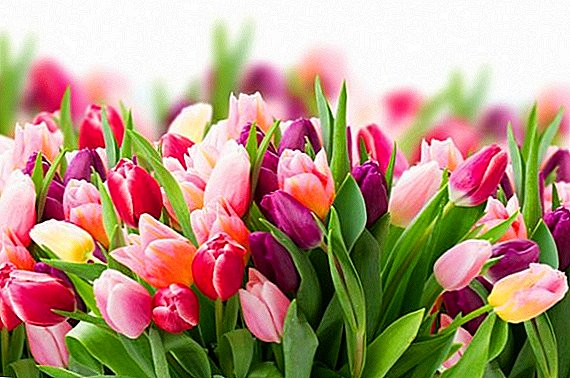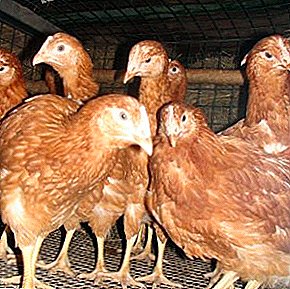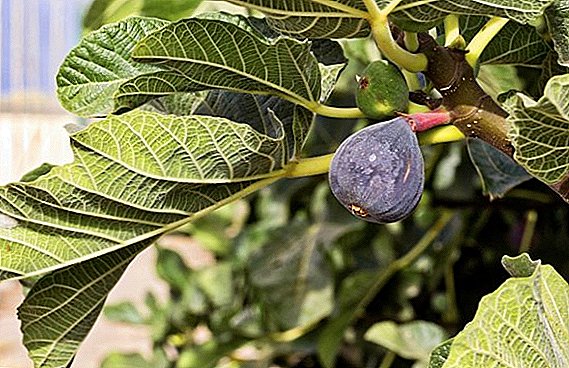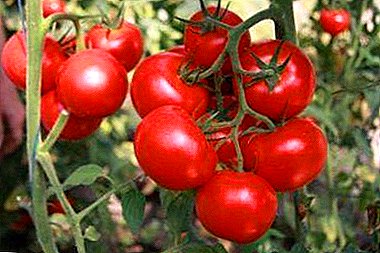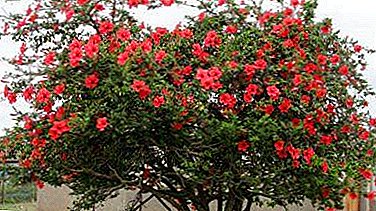
Tree hibiscus is a deciduous shrub that blooms throughout the summer. In the natural environment, it can reach heights of up to 6 m, however, in conditions of moderate strip, it grows up to 2.5 m.
The wide palette of colors and simplicity in the care makes it very popular among gardeners. Read further what are the types of this plant and which ones are suitable for the formation of bonsai, their photos. What conditions are needed for their comfortable growth in the garden. How it multiplies and the plant, as well as what diseases and pests can destroy the plant.
What species are tree?
Tree hibiscus is characterized by the ability to form a solid trunk. Its most popular varieties for cultivation in the open field: lavender chiffon and Duc de Brabant. Both of them are a variety of Syrian hibiscus that grows well in the open field and easily tolerates winter with proper care.
A photo
Here you can see a photo of a tree hibiscus:



Garden care
If you create a comfortable environment for the tree-like hibiscus, it can live up to 15 years.
Temperature
Hibiscus comes from tropical countries, so it copes well with high temperatures. For flowering, its optimal value will be 20-25 0WITH, and in the cold season the garden hibiscus feels comfortable at temperatures up to -5-10 0C. Lower values can kill the plant.
Important! Do not allow sudden changes in temperature. To prevent this from happening, you should land or transfer hibiscus to the street when the danger of frost leaves.
Watering
Hibiscus can tolerate drought, but it adversely affects flowering. The irrigation regimen will be optimal once every 2-3 days, but in particularly arid areas in summer it may be necessary daily. During a drought, the leaves of the plant can be moistened with an atomizer, but do not do this when the sun is at its zenith, otherwise the leaves can burn.
Lighting
Hibiscus loves good lighting. In the shade, it can slow growth and stop blooming. At the same time, it is necessary to ensure that there are no strong winds and drafts at the growth site of the tree.
Priming
The soil should be well drained and fertile. When planting trees on the site in the planting pit, you can add:
- Drainage layer 15 cm.
- Sand 10 cm.
- Compost 15 cm.
- Once again the sand, 15 cm.
The size of the landing pit should be 2 times the size of the root system.
Pruning
Formative pruning should be carried out in the spring. In this case, you can cut to 1/3 the length of the shoots, in their place will quickly appear new.
It is also worth to pruning in preparation for the winter. However, at this time, it is enough just to cut the flower stalks, seed boxes and shorten the shoots.
Top dressing
The plant must be fed with phosphate and nitrogen fertilizers once every 10-14 days, especially during the flowering period. Starting in September, you can prepare the plant for wintering. and add potash supplements to his diet.
Pot
If you wish to plant hibiscus in a pot, you need to choose a fairly spacious container at the rate of 0.5 m2 soil on an adult plant. Good drainage is required.
Wintering
Reference. Hybrid varieties of hibiscus can withstand frosts down to -30 0WITH.
However, when the winter is long, it must be covered. If the plant is young, it is better to transplant it in a pot and clean it up at all until spring.
Transplant: step by step instructions
 A young plant can be transplanted as needed, and an adult tree does not need it at all. It is enough to loosen the soil and change its top layer. If a transplant is needed, it can be done in early spring:
A young plant can be transplanted as needed, and an adult tree does not need it at all. It is enough to loosen the soil and change its top layer. If a transplant is needed, it can be done in early spring:
- Trim the branches to about a third or even half the length.
- Moisturize the soil.
- Carefully reach the root system. You can pry it with a shovel, so as not to injure the roots.
- Inspect the roots, if necessary, remove dead or sick.
- Plant in a new place.
Bonsai
It is believed that hibiscus is not suitable for growing bonsai. The main reasons: very large leaves, and fragile branches that are easy to break when working. However, it is unpretentious in care, affordable and growing quite quickly, which makes it popular for bonsai despite these shortcomings.
Virtually any type of ornamental tree hibiscus can be suitable for bonsai, however, Cooper's hibiscus and rasseten-like are very popular.
How to care?
Hibiscus loves lit places. You can put it on the south or west window. It is important that the tree does not stand in the draft.
Hibiscus does not like stagnant moisture at the roots, and if it is grown in the form of bonsai, it becomes an even more important condition. Excessive humidity will lead to rotting of the roots and the death of the plant. However, overdrying of the soil should not be allowed.
In winter, the temperature around 12-14 will be comfortable for hibiscus. 0WITH. During the flowering period, its value should be around 20-25 0WITH.
Breeding
Hibiscus can be propagated in several ways: cuttings, dividing the bush or seeds.
Cuttings
This is the most popular method, since it is quite simple, and its results are stable. The best time for him is summer.
- Take the apical or slightly green branch.
- Count off at least 3-5 leaves and make an oblique cut slightly above the leaf.
- Lower leaves and peduncle on the stem pruned.
- Root in the substrate or water. If rooted in water, the container should be opaque. In the substrate, the stalk will take root faster and produce stronger roots.
Important! For any kind of rooting, the cutting should be covered with a small greenhouse. For this fit plastic bag or bottle. The main thing is that the walls of the greenhouse do not touch the leaves of the cutting.
Seeds
 This method does not give such stable results, however, it is good for growing hibiscus, obtained by pollinating the parent hybrid plants.
This method does not give such stable results, however, it is good for growing hibiscus, obtained by pollinating the parent hybrid plants.
- Prepare the soil: mix humus and river sand in equal parts.
- Spread the seeds over the surface and sprinkle them with a layer of soil about 1.5 cm thick.
- Cover with glass and water the soil as it dries.
The optimum temperature for germination is 20 0C. Dive seedlings can be at the appearance of the first true leaflet.
Dividing bush
This method is quite simple and will help rejuvenate the existing plant. Suitable for shrubs.
- Dig a bush.
- Split root system. Leave on each part of the growth point.
- Cover with foam and leave at 18-20 0WITH.
- A month later, you can land on a permanent place.
Briefly about diseases and pests
Most common Hibiscus pests are aphids, spider mites, whiteflies and worms. So that they do not hit the plant, you need to periodically wash it with warm water and moisten the air in the room. If it still happened, the plant must be processed, and the damaged shoots removed.
The hibiscus buds may fall off or the leaves turn yellow. This usually happens from improper care. Most likely, the soil in the pot is dry or insufficiently fertilized. Also, the cause may be a sudden change in temperature.
Hibiscus bloom continues throughout the summer. Each flower reveals just a day, but the next day a new one will appear. The tree hibiscus is unpretentious and able to acquire various forms under the close attention of the grower. This can be a standard tree and an interesting bonsai in the apartment. The main thing - to comply with the basic rules of care.


